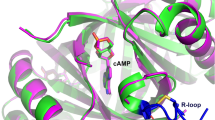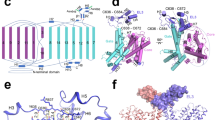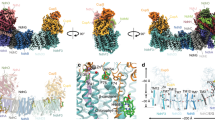Abstract
Bicarbonate transporters play essential roles in pH homeostasis in mammals and photosynthesis in aquatic photoautotrophs. A number of bicarbonate transporters have been characterized, among which is BicA—a low-affinity, high-flux SLC26-family bicarbonate transporter involved in cyanobacterial CO2-concentrating mechanisms (CCMs) that accumulate CO2 and improve photosynthetic carbon fixation. Here, we report the three-dimensional structure of BicA from Synechocystis sp. PCC6803. Crystal structures of the transmembrane domain (BicATM) and the cytoplasmic STAS domain (BicASTAS) of BicA were solved. BicATM was captured in an inward-facing HCO3−-bound conformation and adopts a ‘7+7’ fold monomer. HCO3− binds to a cytoplasm-facing hydrophilic pocket within the membrane. BicASTAS is assembled as a compact homodimer structure and is required for the dimerization of BicA. The dimeric structure of BicA was further analysed using cryo-electron microscopy and physiological analysis of the full-length BicA, and may represent the physiological unit of SLC26-family transporters. Comparing the BicATM structure with the outward-facing transmembrane domain structures of other bicarbonate transporters suggests an elevator transport mechanism that is applicable to the SLC26/4 family of sodium-dependent bicarbonate transporters. This study advances our knowledge of the structures and functions of cyanobacterial bicarbonate transporters, and will inform strategies for bioengineering functional BicA in heterologous organisms to increase assimilation of CO2.
This is a preview of subscription content, access via your institution
Access options
Access Nature and 54 other Nature Portfolio journals
Get Nature+, our best-value online-access subscription
$29.99 / 30 days
cancel any time
Subscribe to this journal
Receive 12 digital issues and online access to articles
$119.00 per year
only $9.92 per issue
Buy this article
- Purchase on Springer Link
- Instant access to full article PDF
Prices may be subject to local taxes which are calculated during checkout







Similar content being viewed by others
References
Cordat, E. & Casey, J. R. Bicarbonate transport in cell physiology and disease. Biochem. J. 417, 423–439 (2009).
Miller, A. G., Espie, G. S. & Canvin, D. T. Physiological aspects of CO2, and HCO3—transport by cyanobacteria: a review. Can. J. Bot. 68, 1291–1302 (1990).
Murray, R. B. & Price, G. D. CO2 concentrating mechanisms in cyanobacteria: molecular components, their diversity and evolution. J. Exp. Bot. 54, 609–622 (2003).
Mackinder, L. C. M. et al. A spatial interactome reveals the protein organization of the algal CO2-concentrating mechanism. Cell 171, 133–147 (2017).
Omata, T. et al. Identification of an ATP-binding cassette transporter involved in bicarbonate uptake in the cyanobacterium Synechococcus sp. strain PCC 7942. Proc. Natl Acad. Sci. USA 96, 13571–13576 (1999).
Shibata, M. et al. Genes essential to sodium-dependent bicarbonate transport in cyanobacteria: function and phylogenetic analysis. J. Biol. Chem. 277, 18658–18664 (2002).
Price, G. D., Woodger, F. J., Badger, M. R., Howitt, S. M. & Tucker, L. Identification of a SulP-type bicarbonate transporter in marine cyanobacteria. Proc. Natl Acad. Sci. USA 101, 18228–18233 (2004).
Shibata, M. et al. Distinct constitutive and low CO2-induced CO2 uptake systems in cyanobacteria: genes involved and their phylogenetic relationship with homologous genes in other organisms. Proc. Natl Acad. Sci. USA 98, 11789–11794 (2001).
Faulkner, M. et al. Direct characterization of the native structure and mechanics of cyanobacterial carboxysomes. Nanoscale 9, 10662–10673 (2017).
Kerfeld, C. A. & Melnicki, M. R. Assembly, function and evolution of cyanobacterial carboxysomes. Curr. Opin. Plant Biol. 31, 66–75 (2016).
Sun, Y. et al. Light modulates the biosynthesis and organization of cyanobacterial carbon fixation machinery through photosynthetic electron flow. Plant Physiol. 171, 530–541 (2016).
Sun, Y., Wollman, A. J. M., Huang, F., Leake, M. C. & Liu, L. N. Single-organelle quantification reveals stoichiometric and structural variability of carboxysomes dependent on the environment. Plant Cell 31, 1648–1664 (2019).
Price, G. D. Inorganic carbon transporters of the cyanobacterial CO2 concentrating mechanism. Photosynth. Res. 109, 47–57 (2011).
Price, G. D., Sültemeyer, D., Klughammer, B., Ludwig, M. & Badger, M. R. The functioning of the CO2 concentrating mechanism in several cyanobacterial strains: a review of general physiological characteristics, genes, proteins, and recent advances. Can. J. Bot. 76, 973–1002 (1996).
Price, G. D., Badger, M. R., Woodger, F. J. & Long, B. M. Advances in understanding the cyanobacterial CO2-concentrating-mechanism (CCM): functional components, Ci transporters, diversity, genetic regulation and prospects for engineering into plants. J. Exp. Bot. 59, 1441–1461 (2008).
McGrath, J. M. & Long, S. P. Can the cyanobacterial carbon-concentrating mechanism increase photosynthesis in crop species? A theoretical analysis. Plant Physiol. 164, 2247–2261 (2014).
Rae, B. D. et al. Progress and challenges of engineering a biophysical CO2-concentrating mechanism into higher plants. J. Exp. Bot. 68, 3717–3737 (2017).
Rolland, V., Badger, M. R. & Price, G. D. Redirecting the cyanobacterial bicarbonate transporters BicA and SbtA to the chloroplast envelope: soluble and membrane cargos need different chloroplast targeting signals in plants. Front. Plant Sci. 7, 185 (2016).
Uehara, S., Adachi, F., Ito-Inaba, Y. & Inaba, T. Specific and efficient targeting of cyanobacterial bicarbonate transporters to the inner envelope membrane of chloroplasts in Arabidopsis. Front. Plant Sci. 7, 16 (2016).
Pengelly, J. J. et al. Transplastomic integration of a cyanobacterial bicarbonate transporter into tobacco chloroplasts. J. Exp. Bot. 65, 3071–3080 (2014).
Price, G. D. & Howitt, S. M. Topology mapping to characterize cyanobacterial bicarbonate transporters: BicA (SulP/SLC26 family) and SbtA. Mol. Membr. Biol. 31, 177–182 (2014).
Shelden, M. C., Howitt, S. M. & Price, G. D. Membrane topology of the cyanobacterial bicarbonate transporter, BicA, a member of the SulP (SLC26A) family. Mol. Membr. Biol. 27, 12–22 (2010).
Alper, S. L. & Sharma, A. K. The SLC26 gene family of anion transporters and channels. Mol. Aspects Med. 34, 494–515 (2013).
Alka, K. & Casey, J. R. Bicarbonate transport in health and disease. IUBMB Life 66, 596–615 (2014).
Nakajima, K., Tanaka, A. & Matsuda, Y. SLC4 family transporters in a marine diatom directly pump bicarbonate from seawater. Proc. Natl Acad. Sci. USA 110, 1767–1772 (2013).
Felce, J. & Saier, M. H. Jr. Carbonic anhydrases fused to anion transporters of the SulP family: evidence for a novel type of bicarbonate transporter. J. Mol. Microbiol. Biotechnol. 8, 169–176 (2004).
Igarashi, T. et al. Mutations in SLC4A4 cause permanent isolated proximal renal tubular acidosis with ocular abnormalities. Nat. Genet. 23, 264–266 (1999).
Rungroj, N. et al. A novel missense mutation in AE1 causing autosomal dominant distal renal tubular acidosis retains normal transport function but is mistargeted in polarized epithelial cells. J. Biol. Chem. 279, 13833–13838 (2004).
Kere, J., Sistonen, P., Holmberg, C. & de la Chapelle, A. The gene for congenital chloride diarrhea maps close to but is distinct from the gene for cystic fibrosis transmembrane conductance regulator. Proc. Natl Acad. Sci. USA 90, 10686–10689 (1993).
Wedenoja, S. et al. Update on SLC26A3 mutations in congenital chloride diarrhea. Hum. Mutat. 32, 715–722 (2011).
Everett, L. A. et al. Pendred syndrome is caused by mutations in a putative sulphate transporter gene (PDS). Nat. Genet. 17, 411–422 (1997).
Park, H. J. et al. Origins and frequencies of SLC26A4 (PDS) mutations in east and south Asians: global implications for the epidemiology of deafness. J. Med. Genet. 40, 242–248 (2003).
Arakawa, T. et al. Crystal structure of the anion exchanger domain of human erythrocyte band 3. Science 350, 680–684 (2015).
Huynh, K. W. et al. CryoEM structure of the human SLC4A4 sodium-coupled acid-base transporter NBCe1. Nat. Commun. 9, 900 (2018).
Geertsma, E. R. et al. Structure of a prokaryotic fumarate transporter reveals the architecture of the SLC26 family. Nat. Struct. Mol. Biol. 22, 803–808 (2015).
Alguel, Y. et al. Structure of eukaryotic purine/H+ symporter UapA suggests a role for homodimerization in transport activity. Nat. Commun. 7, 11336 (2016).
Xu, M. et al. Properties of mutants of Synechocystis sp. strain PCC 6803 lacking inorganic carbon sequestration systems. Plant Cell Physiol. 49, 1672–1677 (2008).
Thurtle-Schmidt, B. H. & Stroud, R. M. Structure of Bor1 supports an elevator transport mechanism for SLC4 anion exchangers. Proc. Natl Acad. Sci. USA 113, 10542–10546 (2016).
Lu, F. et al. Structure and mechanism of the uracil transporter UraA. Nature 472, 243–246 (2011).
Yu, X. et al. Dimeric structure of the uracil:proton symporter UraA provides mechanistic insights into the SLC4/23/26 transporters. Cell Res. 27, 1020–1033 (2017).
Yamashita, A., Singh, S. K., Kawate, T., Jin, Y. & Gouaux, E. Crystal structure of a bacterial homologue of Na+/Cl– dependent neurotransmitter transporters. Nature 437, 215–223 (2005).
Mancusso, R., Gregorio, G. G., Liu, Q. & Wang, D. N. Structure and mechanism of a bacterial sodium-dependent dicarboxylate transporter. Nature 491, 622–626 (2012).
Jennings, M. L. & Smith, J. S. Anion-proton cotransport through the human red blood cell band 3 protein. Role of glutamate 681. J. Biol. Chem. 267, 13964–13971 (1992).
Detro-Dassen, S. et al. Conserved dimeric subunit stoichiometry of SLC26 multifunctional anion exchangers. J. Biol. Chem. 283, 4177–4188 (2008).
Greeson, J. N., Organ, L. E., Pereira, F. A. & Raphael, R. M. Assessment of prestin self-association using fluorescence resonance energy transfer. Brain Res. 1091, 140–150 (2006).
Compton, E. L., Karinou, E., Naismith, J. H., Gabel, F. & Javelle, A. Low resolution structure of a bacterial SLC26 transporter reveals dimeric stoichiometry and mobile intracellular domains. J. Biol. Chem. 286, 27058–27067 (2011).
Srinivasan, L., Baars, T. L., Fendler, K. & Michel, H. Functional characterization of solute carrier (SLC) 26/sulfate permease (SulP) proteins in membrane mimetic systems. Biochim. Biophys. Acta 1858, 698–705 (2016).
Gorbunov, D. et al. Molecular architecture and the structural basis for anion interaction in prestin and SLC26 transporters. Nat. Commun. 5, 3622 (2014).
Dorwart, M. R. et al. Congenital chloride-losing diarrhea causing mutations in the STAS domain result in misfolding and mistrafficking of SLC26A3. J. Biol. Chem. 283, 8711–8722 (2008).
Dossena, S. et al. Molecular and functional characterization of human pendrin and its allelic variants. Cell. Physiol. Biochem. 28, 451–466 (2011).
Drew, D. & Boudker, O. Shared molecular mechanisms of membrane transporters. Annu. Rev. Biochem. 85, 543–572 (2016).
Compton, E. L. et al. Conserved structure and domain organization among bacterial SLC26 transporters. Biochem. J. 463, 297–307 (2014).
Walter, J. D., Sawicka, M. & Dutzler, R. Cryo-EM structures and functional characterization of murine Slc26a9 reveal mechanism of uncoupled chloride transport. eLife 8, 46986 (2019).
Ko, S. B. et al. Gating of CFTR by the STAS domain of SLC26 transporters. Nat. Cell Biol. 6, 343–350 (2004).
Shibagaki, N. & Grossman, A. R. Binding of cysteine synthase to the STAS domain of sulfate transporter and its regulatory consequences. J. Biol. Chem. 285, 25094–25102 (2010).
Fang, Y. et al. Engineering and modulating functional cyanobacterial CO2-fixing organelles. Front. Plant Sci. 9, 739 (2018).
Lin, M. T., Occhialini, A., Andralojc, P. J., Parry, M. A. & Hanson, M. R. A faster Rubisco with potential to increase photosynthesis in crops. Nature 513, 547–550 (2014).
Long, B. M. et al. Carboxysome encapsulation of the CO2-fixing enzyme Rubisco in tobacco chloroplasts. Nat. Commun. 9, 3570 (2018).
Casella, S. et al. Dissecting the native architecture and dynamics of cyanobacterial photosynthetic machinery. Mol. Plant 10, 1434–1448 (2017).
Bao, Z. et al. Structure and mechanism of a group-I cobalt energy coupling factor transporter. Cell Res. 27, 675–687 (2017).
Minor, W., Cymborowski, M., Otwinowski, Z. & Chruszcz, M. HKL-3000: the integration of data reduction and structure solution—from diffraction images to an initial model in minutes. Acta Crystallogr. D 62, 859–866 (2006).
Adams, P. D. et al. PHENIX: a comprehensive Python-based system for macromolecular structure solution. Acta Crystallogr. D 66, 213–221 (2010).
Emsley, P. & Cowtan, K. Coot: model-building tools for molecular graphics. Acta Crystallogr. D 60, 2126–2132 (2004).
Slotboom, D. J., Duurkens, R. H., Olieman, K. & Erkens, G. B. Static light scattering to characterize membrane proteins in detergent solution. Methods 46, 73–82 (2008).
Huang, F. et al. Roles of RbcX in carboxysome biosynthesis in the cyanobacterium Synechococcus elongatus PCC7942. Plant Physiol. 179, 184–194 (2019).
Liu, L. N. et al. Control of electron transport routes through redox-regulated redistribution of respiratory complexes. Proc. Natl Acad. Sci. USA 109, 11431–11436 (2012).
Zheng, S. Q. et al. MotionCor2: anisotropic correction of beam-induced motion for improved cryo-electron microscopy. Nat. Methods 14, 331–332 (2017).
Zhang, K. Gctf: real-time CTF determination and correction. J. Struct. Biol. 193, 1–12 (2016).
Scheres, S. H. RELION: implementation of a Bayesian approach to cryo-EM structure determination. J. Struct. Biol. 180, 519–530 (2012).
Pettersen, E. F. et al. UCSF Chimera—a visualization system for exploratory research and analysis. J. Comput. Chem. 25, 1605–1612 (2004).
Acknowledgements
We thank the staff members of the BL19U1 and BL17U1 beamlines at the SSRF and the National Protein Science Center (Shanghai) for technical assistance in diffraction data and SEC–MALS (J. Zhang) data collection; the staff members at the cryo-EM center of University of Science and Technology of China and National Protein Science Center (Shanghai) for cryo-EM analysis and data collection; and the staff members at the core facility center of Institute of Plant Physiology and Ecology for X-ray diffraction analysis. We also thank the Liverpool Center for Cell imaging for technical assistance and provision of confocal microscopy. This work was supported by grants from the National Natural Science Foundation of China (grant no. 31861130356 to P.Z.), the Ministry of Science and Technology of China (grant no. 2015CB910900 to P.Z.), the Chinese Academy of Sciences (XDB27020103 and QYZDB-SSW-SMC006 to P.Z.); the Royal Society (NAF/R1/180433 to P.Z. and UF120411 and URF/R/180030 to L.-N.L.), the Biotechnology and Biological Sciences Research Council (BB/M024202/1 and BB/R003890/1 to L.-N.L.), an award from the University of Liverpool Technology Directorate Voucher Scheme (to F.H.) and the Leverhulme Trust Early Career Fellowship (ECF-2016-778 to F.H.).
Author information
Authors and Affiliations
Contributions
P.Z. conceived the project. C.W. and P.Z. designed the experiments. C.W. performed the majority of the experiments; B.S. contributed to the LCP crystallization; X.Z. and X.H. performed the cryo-EM study; H.G. and F.Y. contributed to protein expression and crystallization; M.Z. contributed to transport assay analysis; X.C. and H.M. contributed to growth assay analysis; F.H., T.C. and L.-N.L. performed genetic GFP fusion and live-cell imaging. P.Z. and C.W. solved the crystal structures. P.Z., L.-N.L. and C.W. wrote the manuscript with inputs from all of the authors.
Corresponding author
Ethics declarations
Competing interests
The authors declare no competing interests.
Additional information
Peer review information Nature Plants thanks Alistair McCormick and the other, anonymous, reviewers for their contribution to the peer review of this work.
Publisher’s note Springer Nature remains neutral with regard to jurisdictional claims in published maps and institutional affiliations.
Extended data
Extended Data Fig. 1 BicA activity and purification.
a, Growth curves of Synechocystis sp. PCC6803 WT and Δ4/Δ5 mutants bubbled with air plus 1% CO2. b, H14CO3- uptake activity assayed using Synechocystis sp. PCC6803 WT and Δ4/Δ5 mutants. (Values are mean ± SD, n=3). c, SDS-PAGE shows the purification results of transmembrane domain truncations, and STAS domain truncations (d). The gels were stained with Coomassie blue. (Experiments were repeated at least three times).
Extended Data Fig. 2 Electron density and crystal packing of BicATM393.
a, 2Fo-Fc electron density of TM-1, -3, -8. The density is contoured at 1.5 σ. b, Crystal packing of BicATM. The crystal is of space group P2 and contains two molecules (colored in yellow and magenta) in the asymmetric unit. c, Fo-Fc electron densities of HCO3- and the metal ion (contoured at 2.0 σ). d, 2Fo-Fc electron density of monoolein (contoured at 1.0 σ).
Extended Data Fig. 3 Potential Na+ binding site.
a, Potential Na+-binding site in BicA. b, Na+-binding site in the Na+- dependent dicarboxylate transporter VcINDY (PDB 4F35). c, Na+- binding site in a bacterial homologue of Na+/Cl--dependent neurotransmitter transporters LeuT (PDB 2A65).
Extended Data Fig. 4 The stable dimeric structure of BicASTAS.
a, Three-layered dimer of BicASTAS. The helices of the bottom layer and top layer are colored in dark blue, and the β-sheets of the middle layer are colored in cyan. b, SDS-PAGE shows the chemical cross- linking experimental results of different truncations of BicASTAS, Experiments were repeated at least three times. c/d, Topology of BicASTAS and SLC26DgSTAS. e, SLC26DgSTAS (colored in light blue) forms a heterodimer with the nanobody Nb5776 (colored in light grey) through forming a 10-stranded β-sheet (PDB 5IOF).
Extended Data Fig. 5 Oligomeric state of BicA full-length and transmembrane- domain.
Chemical cross-linking results of BicA (a) and transmembrane domain only (b). Three independent experiments have been carried with similar results.
Extended Data Fig. 6 Cryo-EM structure of BicA.
a, Representative micrograph. b, 2D class averages. c, Fourier shell correlation curve. d, Three different views of BicA reconstruction.
Extended Data Fig. 7 Sequence alignment of the STAS domain of Synechocystis sp. PCC6803 BicA and human SLC26A2-4.
The gene ID are 499176153 (Syn6803_BicA), 37590805 (Hp_SLC26A2), 19343676 (Hp_SLC26A3) and 119603820 (Hp_SLC26A4), respectively. The positions of human disease mutations in human SLC26A2-4 are indicated with blue triangles.
Extended Data Fig. 8 Structural comparison with other SLC family transporters.
a, Core domain superimposition of BicATM (orange) and NBCe1CTD (light grey). The RMSD is 2.5Å. b, Gate domain superimposition of BicATM (blue) and NBCe1CTD (light grey). The RMSD is 3.0Å. c, Superimposition of BicATM and NBCe1CTD. The RMSD is 3.8Å. d, Differences of the dimer interaction surface among AE1, NBCe1, Bor1, UapA and UraA transporters. The structure elements involved the dimerization are colored magenta in AE1, NBCe1 and Bor1 transporters (SLC4 family), and red in UapA and UraA transporters (SLC23 family).
Extended Data Fig. 9 PCR analysis of different BicA mutants.
Three independent experiments have been carried with similar results.
Supplementary information
Supplementary Table 1
Summary of the statistics for X-ray diffraction data collection, structure determination and refinement.
Rights and permissions
About this article
Cite this article
Wang, C., Sun, B., Zhang, X. et al. Structural mechanism of the active bicarbonate transporter from cyanobacteria. Nat. Plants 5, 1184–1193 (2019). https://doi.org/10.1038/s41477-019-0538-1
Received:
Accepted:
Published:
Issue Date:
DOI: https://doi.org/10.1038/s41477-019-0538-1
This article is cited by
-
Structure and assembly of the α-carboxysome in the marine cyanobacterium Prochlorococcus
Nature Plants (2024)
-
Mechanism of anion exchange and small-molecule inhibition of pendrin
Nature Communications (2024)
-
Elevator-like movements of prestin mediate outer hair cell electromotility
Nature Communications (2023)
-
Engineering α-carboxysomes into plant chloroplasts to support autotrophic photosynthesis
Nature Communications (2023)
-
Structure, dynamics and assembly of the ankyrin complex on human red blood cell membrane
Nature Structural & Molecular Biology (2022)



